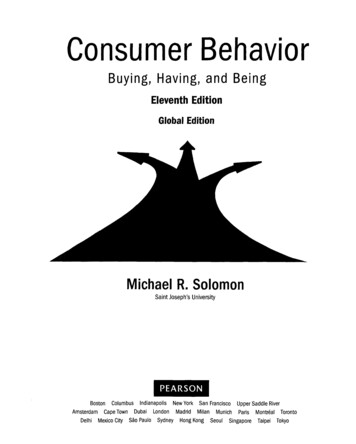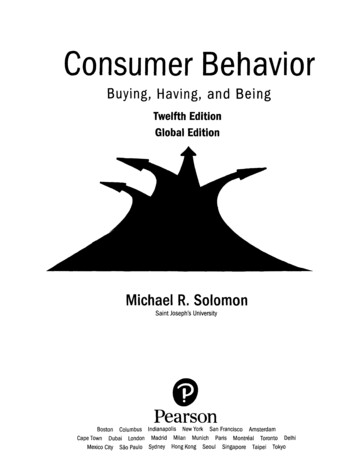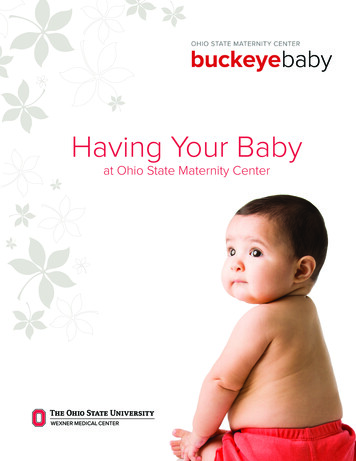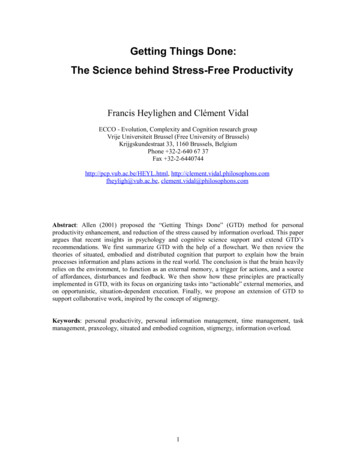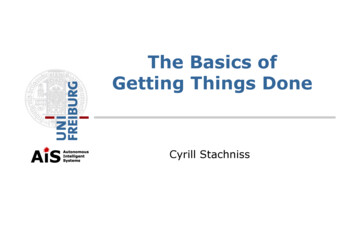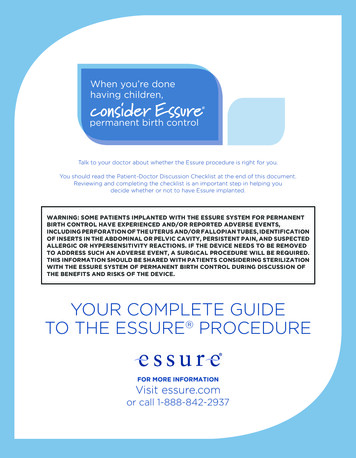
Transcription
Your Complete Guide: The Essure ProcedureWhen you’re donehaving children,consider Essurepermanent birth control Talk to your doctor about whether the Essure procedure is right for you.You should read the Patient-Doctor Discussion Checklist at the end of this document.Reviewing and completing the checklist is an important step in helping youdecide whether or not to have Essure implanted.WARNING: SOME PATIENTS IMPLANTED WITH THE ESSURE SYSTEM FOR PERMANENTBIRTH CONTROL HAVE EXPERIENCED AND/OR REPORTED ADVERSE EVENTS,INCLUDING PERFORATION OF THE UTERUS AND/OR FALLOPIAN TUBES, IDENTIFICATIONOF INSERTS IN THE ABDOMINAL OR PELVIC CAVITY, PERSISTENT PAIN, AND SUSPECTEDALLERGIC OR HYPERSENSITIVITY REACTIONS. IF THE DEVICE NEEDS TO BE REMOVEDTO ADDRESS SUCH AN ADVERSE EVENT, A SURGICAL PROCEDURE WILL BE REQUIRED.THIS INFORMATION SHOULD BE SHARED WITH PATIENTS CONSIDERING STERILIZATIONWITH THE ESSURE SYSTEM OF PERMANENT BIRTH CONTROL DURING DISCUSSION OFTHE BENEFITS AND RISKS OF THE DEVICE.YOUR COMPLETE GUIDETO THE ESSURE PROCEDUREFOR MORE INFORMATIONVisit essure.comor call 1-888-842-29371
2
Your Complete Guide: The Essure ProcedureTABLE OF CONTENTSGlossary 4What is Essure ? 5The Benefits of Essure 6Essure Procedure Overview 7Warnings, Precautions and other Potential Risks 8Questions to Ask Your Doctor 10What to Expect with Essure 11Patient Identification Card 12Frequently Asked Questions 13How Essure Performed in Clinical Studies 14How Essure has Performed since FDA Approval in 2002 15Comparison of Permanent Birth Control Methods 17Comparison of Temporary Birth Control Methods 19Patient-Doctor Discussion Checklist Back Cover3
Your Complete Guide: The Essure ProcedureGLOSSARYAnesthesia: Medically-induced partial or complete loss of sensation in all or part of the body. Lossof sensation may occur with or without loss of consciousness.Cervix: The passageway that connects the vagina with the uterus.Contraceptive: Any process, device, or method that reduces the likelihood of pregnancy.Ectopic Pregnancy: The development of a fertilized egg outside the uterus, such as in a fallopiantube. Ectopic pregnancies can be dangerous and possibly life threatening.Endometrial Ablation: A procedure that removes the lining of the uterus to lighten or stop yourperiods.Essure Insert: The small, soft, flexible device that is placed in your fallopian tubes for permanentpregnancy prevention.Fallopian Tubes: The tubes that carry the eggs from the ovaries to the uterus.General Anesthesia: Medication that induces total loss of consciousness and sensation.Hysteroscope: An instrument that is passed through the vagina and cervix to view the inside of theuterus.In Vitro Fertilization (IVF): Fertilization of an egg outside the body. Once fertilized, the eggis placed into the uterus.Local Anesthetic: Medication that is applied or injected to numb a certain part of the body.Modified Hysterosalpingogram (modified HSG): An x-ray of the uterus and fallopian tubesafter contrast dye has been given for the Essure Confirmation Test.Occlusion: An obstruction or a closure of a passageway or a vessel.Transvaginal Ultrasound (TVU): A test used to look at a woman’s reproductive organs. Anultrasound device is placed into the vagina, and sound waves are used to see the uterus andfallopian tubes.Tubal Ligation: A form of permanent birth control by means of cutting, tying, burning or clippingthe fallopian tubes so that they are blocked.Uterus: The womb, where a developing fetus grows.Vasectomy: Permanent birth control for men that involves cutting or blocking a segment of the vasdeferens (the tubes that carry the sperm).4
Your Complete Guide: The Essure ProcedureWHAT IS ESSURE (ESSURE)?Essure is a permanent birth control procedure that workswith your body to create a natural barrier against pregnancy.The Essure procedure involves placing soft, flexible insertsinto your fallopian tubes. Over a period of about threemonths, tissue forms around the inserts. The build-up oftissue creates a barrier that keeps sperm from reaching theeggs and prevents conception.Essure insert - actual sizeEssure was approved in 2002 by the FDA. Over 750,000 women and their doctors have chosenEssure for permanent birth control (based on units sold worldwide).Essure may be right for you if: You are certain you do not want any more children. You desire a permanent form of birth control. You would like to stop worrying about getting pregnant. You prefer a method or procedure that:- Does not take a lot of time.- Can be done in your doctor’s office.- Does not require cutting and leaves no visible scars.- Does not contain any hormones.Essure is NOT right for you if: You are uncertain about ending your fertility. You suspect you are pregnant. You have only one fallopian tube. You have one or both fallopian tubes closed or obstructed. You have had your “tubes tied” (tubal ligation). You are allergic to contrast dye used during x-ray exams. You are unwilling to undergo the Essure Confirmation Test. You have unexplained vaginal bleeding. You have suspected or known cancer of the female reproductive organs.You should delay having the Essure procedure if: You are or have been pregnant within the past 6 weeks. You have an active gynecological infection. You are in the second half (weeks 3 and 4) of your menstrual cycle. During that time, there is anincreased risk of being pregnant prior to having the Essure procedure.5
Your Complete Guide: The Essure ProcedureYou should speak to your doctor if: You are taking or receiving therapy that suppresses your immune system. Examples includechemotherapy or corticosteroids, such as prednisone. Therapy that suppresses the immunesystem may make the Essure procedure less effective for birth control. You have, or think that you may have, a history of metal allergies, or an allergy to polyesterfibers, nickel-titanium, platinum, silver-tin, or stainless steel or any other components of theEssure system. You are currently using an IUD for contraception. If you have already had, or are considering a procedure to reduce bleeding from the uterus(such as endometrial ablation) tell your doctor as it may affect the Essure procedure.- The ablation procedure should not be performed on the same day as your Essureplacement procedure.- If you have Essure placed, your doctor must confirm that it is in a satisfactory location(via the Essure Confirmation Test) before performing an ablation procedure.Talk to your doctor about Essure and if it is right for you. Refer to the Patient-Doctor DiscussionChecklist in this booklet and review it with your doctor.IMPORTANT: Essure inserts do not protect against HIV or other sexually transmitted diseases.THE BENEFITS OF ESSUREMinimally Invasive Procedure: Essure placement requires no cutting, leaves no visible scars,and can be performed in your doctor’s office.No General Anesthesia Required: You can remain fully conscious during the procedure. Yourdoctor may recommend a medication to reduce anxiety and/or use a local (numbing) anestheticto reduce potential discomfort.Non-Hormonal: For patients who prefer or need non-hormonal birth control, Essure inserts donot contain or release hormones.Return to Normal Activity within 1 to 2 days: The majority of women (60%) return to normalactivity within 1 day or less, and more than 75% return to normal activities within 2 days.Short Placement Time: Total procedure time on average is 36 minutes. In the most recent clinicalstudy, over 96% of women were able to have both inserts placed at the first placement attempt.Benefit of Confirmation: An Essure Confirmation Test will verify if both inserts are placedcorrectly and whether you can rely on Essure for birth control. In the most recent clinical study, 92%of women who had placement attempted were told to rely on Essure for birth control.Highly Effective: The Essure procedure is 99.3% effective at preventing pregnancy in patientswho were told to rely on Essure for birth control (based on first year reliance in the most recentclinical study).6
Your Complete Guide: The Essure ProcedureESSURE PROCEDURE OVERVIEWStep 1Placing the Essure insertsThe Essure procedure is usually performed in your doctor’soffice. During the procedure, the doctor will place a tinyinsert into each of your fallopian tubes. The inserts are softand flexible, and are delivered with a tube through yourvagina and cervix, and into your fallopian tubes. No incisionsare needed.Step 2Waiting for the natural barrier to formOver the next 3 months, your body will form tissue aroundthe Essure inserts. The tissue forms a natural barrier withinthe fallopian tubes. The barrier prevents sperm from reachingthe eggs that are produced every month. During the 3-monthperiod, you must continue using another form of birth controlto prevent pregnancy.Since Essure does not contain hormones that interfere withyour body’s menstrual cycle, your ovaries will continue torelease eggs. Since the eggs cannot be fertilized, they aresimply absorbed back into your body.Step 3Essure Confirmation TestThree months after your Essure procedure, you will need tohave an Essure Confirmation Test to determine if you can relyon Essure for birth control. Your doctor will advise you on thetype of test that is right for you. You may have an ultrasoundtest that verifies that your Essure inserts are in the correctlocation, or, your doctor may recommend a test that usescontrast dye and a special type of x-ray to determine boththat your inserts are in the correct location and that yourfallopian tubes are blocked.IMPORTANT: FOR SOME WOMEN, IT MAY TAKE LONGER THAN 3 MONTHS FOR ESSURE TOCOMPLETELY BLOCK THE FALLOPIAN TUBES, REQUIRING A REPEAT CONFIRMATION TESTAT 6 MONTHS.YOU MUST SEE YOUR DOCTOR FOR THE ESSURE CONFIRMATION TEST BEFORE YOU CAN RELYON ESSURE FOR BIRTH CONTROL. YOU MUST CONTINUE TO USE ANOTHER FORM OF BIRTHCONTROL TO PREVENT PREGNANCY UNTIL YOUR DOCTOR TELLS YOU THAT YOUCAN RELY ON ESSURE FOR BIRTH CONTROL.7
Your Complete Guide: The Essure ProcedureWARNINGS, PRECAUTIONS AND OTHER POTENTIAL RISKSWARNING: Be sure you are done having children before you undergo the Essure procedure.Essure is a permanent method of birth control. The younger a woman is when she chooses to end her fertility, the more likely she is to regrether choice later.WARNING: You must continue to use another form of birth control until you have your EssureConfirmation Test and your doctor tells you that you can rely on Essure for birth control. You can rely on Essure for birth control only after your doctor has reviewed your EssureConfirmation Test results and told you that you can rely. If you rely on Essure for birth controlbefore having your Essure Confirmation Test, you are at risk of getting pregnant. Talk to your doctor about which method of birth control you should use for the 3 months after theprocedure. Some women can remain on their current birth control. It can take longer than three months for the Essure procedure to be effective. In rare cases, ithas taken up to 6 months. Make sure to continue using an alternate form of birth control untilyour doctor has reviewed your Essure Confirmation Test results and confirmed that you canrely on Essure for birth control.Risks: During the Essure procedure You may experience mild to moderate pain. Your doctor may be unable to place one or both Essure inserts correctly. I n rare cases, part of an Essure insert may break off during placement. Your doctor will removethe piece, if appropriate. There is a risk of perforation of the uterus or fallopian tube by the hysteroscope, Essure systemor other instruments used during the procedure. In the original premarket studies, perforation dueto the Essure insert occurred in 1.8% of women. A perforation may lead to bleeding or injury tobowel or bladder, which may require surgery. Your body may absorb a large amount of the salt water solution used during the procedure. Your doctor may recommend a local anesthesia, which numbs the cervix. Ask your doctorabout the risks associated with this type of anesthesia.Risks: Immediately following the procedure You may experience mild to moderate pain and/or cramping, vaginal bleeding, and pelvic orback discomfort for a few days after the procedure. Some women experience headaches,nausea and/or vomiting, or dizziness and/or fainting. You should arrange to have someoneavailable to take you home after the procedure. In rare instances, an Essure insert may be expelled from the body. This is usually detectedduring the Essure Confirmation Test.8
Your Complete Guide: The Essure ProcedureRisks: During the Essure Confirmation Test B ecause one of the Essure Confirmation Tests (a modified HSG) requires an x-ray, you may beexposed to very low levels of radiation if an x-ray is performed. This is standard with most x-rays. The following additional risks are associated with the modified HSG: some women may experiencenausea and/or vomiting, dizziness and/or fainting, cramping, pain or discomfort.In rare instances, women may experience spotting and/or infection.Risks: Long-term P ain (e.g. acute or persistent) of varying intensity and length of time may occur and continuefollowing Essure placement. Women with a history of pain prior to placement of Essure aremore likely to experience both acute and persistent pelvic pain following Essure placement.In addition to pain associated with Essure, unrelated gynecological (for example: endometriosis,adenomyosis) or nongynecological (for example: irritable bowel syndrome, interstitial cystitis)conditions may result in pain. Contact your doctor if you are experiencing significant pain or ifthe pain persists. T here are reports of an Essure insert being located in the lower abdomen and pelvis. If thishappens, you cannot rely on Essure for birth control and surgery may be necessary to removethe insert. P atients with known hypersensitivity to polyester fibers, nickel, titanium, stainless steel (iron,chromium nickel), platinum, silver-tin and/or any of the components of the Essure system mayexperience an allergic reaction to the insert. This includes patients with a history of metalallergies. In addition, some patients may develop an allergy to nickel or other components ofthe insert following placement. Symptoms reported in women using Essure that may be associatedwith an allergic reaction include hives, rash, swelling and itching. There is no reliable test topredict who may develop a reaction to the inserts. I f you and your doctor decide that the inserts should be removed after placement, surgery willbe necessary. This may include looking in the uterus (hysteroscopy), removal of the insert alone,removal of the insert with the fallopian tube, and/or, in complicated cases, removal of the uterus(hysterectomy). The doctor who placed Essure may not be the doctor performing the removal. N o birth control method is 100% effective. There is a chance that you can become pregnantafter completing the Essure procedure. In the most recent clinical trial, three women out of 503(0.6%) became pregnant within the first year of relying on Essure. While successful pregnancieswith healthy deliveries have been reported with Essure devices in place, there have been reportsof pregnancy loss, pre-term labor, premature delivery, stillbirth, neonatal complications, andgenetic and developmental abnormalities in pregnancies with Essure. You should contact yourdoctor immediately if you think you may be pregnant. E ctopic pregnancies may occur with Essure. Ectopic pregnancy is when the pregnancy occursoutside of the uterus. The pregnancy usually happens in one of the fallopian tubes. Ectopicpregnancies can be very serious or life-threatening. I f you have endometrial ablation, a procedure that removes the lining of the uterus to lighten orstop menstrual bleeding, after the Essure procedure, it is unknown if this will affect the blockagein your tubes, and effect your risk of pregnancy.9
Your Complete Guide: The Essure ProcedureUnknown risks: O ther symptoms have been reported to FDA by women implanted with Essure, although theywere not seen in the clinical trials supporting Essure approval. The more common symptomsreported include headache, fatigue, weight changes, hair loss and mood changes such asdepression. It is unknown if these symptoms are related to Essure or other causes. T he safety and effectiveness of Essure has not been established in women under 21 or over 45years old. T he safety and effectiveness of reversing the Essure procedure are not known. There are limiteddata related to the effects, including risks, of Essure inserts on in vitro fertilization (IVF).QUESTIONS TO ASK YOUR DOCTORIf you are considering having the Essure procedure, here are some questions you might askyour doctor: Is Essure right for me compared to other birth control methods? Where will my Essure procedure be performed? What type of medications will be used before and/or during my procedure? How should I prepare? What are my options if both inserts cannot be placed on the first attempt? How do I schedule my Essure Confirmation Test? C an I continue to use my current method of birth control until I have the results of myEssure Confirmation Test? How will having Essure impact future gynecological procedures I may have?Talk to your doctor about Essure and if it is right for you. Review the Patient-Doctor DiscussionChecklist in this booklet with your doctor before deciding to have the Essure procedure.10
Your Complete Guide: The Essure ProcedureWHAT TO EXPECT WITH ESSUREPreparing for your procedureYour doctor will schedule your Essure procedure for a time soon after your menstrual period ends.This will make it easier for your doctor to see the openings of your fallopian tubes and place theinserts.The day of your procedureYou will take a pregnancy test before or on the day of your procedure. This will ensure you are notpregnant. Your doctor may also give you medication before your procedure to reduce discomfort.Talk to your doctor about the types of medications that are right for you.During your procedureYour doct
Essure is a permanent birth control procedure that works with your body to create a natural barrier against pregnancy The Essure procedure involves placing soft, flexible inserts into your fallopian tubes Over a period of about thre


